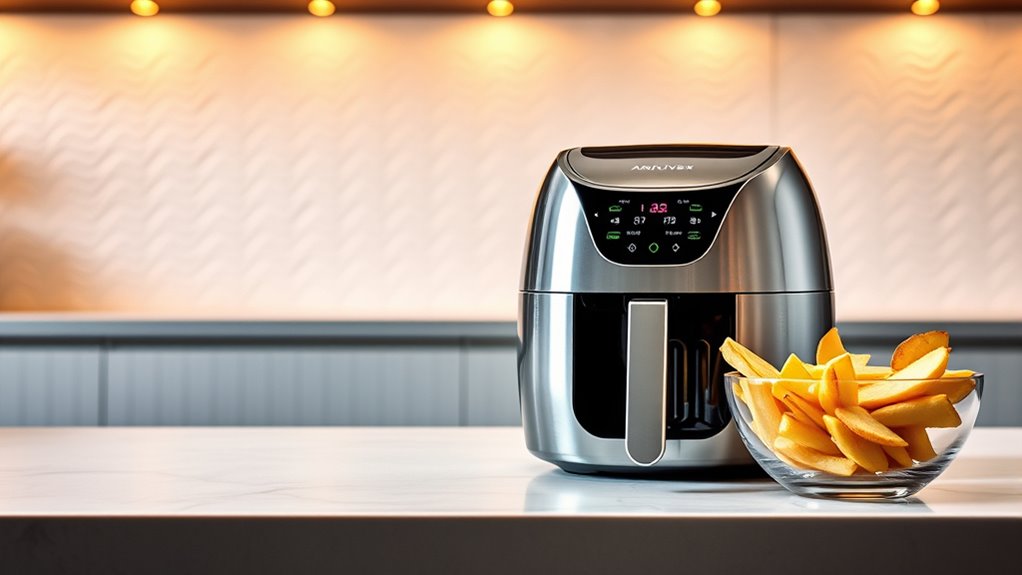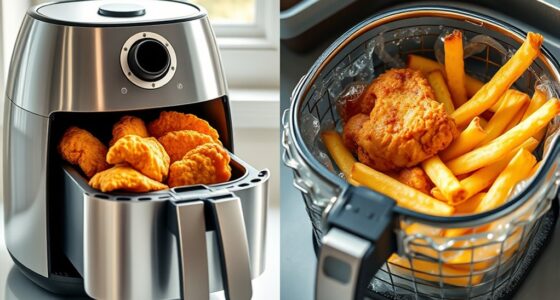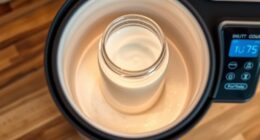Using an air fryer drastically lowers acrylamide formation compared to deep frying, thanks to its lower temperatures and shorter cooking times. Proper preparation, like soaking and drying vegetables, and monitoring temperature can further reduce risks. Foods prone to acrylamide include potatoes and baked goods, but adjusting methods helps keep your meals safer. To understand how to optimize your air frying for health, discover more about best practices and recent findings.
Key Takeaways
- Air frying significantly reduces acrylamide formation compared to deep frying, by limiting high heat and dry conditions.
- Proper techniques like soaking vegetables and avoiding overcooking further decrease acrylamide levels in air-fried foods.
- Keeping cooking temperatures around 350°F (175°C) helps minimize acrylamide while maintaining food quality.
- Monitoring cooking times and browning ensures foods are cooked safely without excessive acrylamide development.
- Using air fryers promotes healthier, safer fried foods with approximately 75-90% lower acrylamide levels than traditional frying methods.
What Is Acrylamide and Why Does It Matter?

Acrylamide is a chemical that forms in carbohydrate-rich foods when you cook them at high temperatures, such as frying, baking, or roasting. It results from the Maillard reaction between sugars and amino acids, which gives foods like fries, bread, and cereals their golden-brown color. While this reaction enhances flavor, it also produces acrylamide, a suspected carcinogen. Food safety experts highlight that high levels of acrylamide may pose health risks, including an increased chance of cancer with prolonged exposure. Different frying methods can influence how much acrylamide forms, making food preparation choices important. Cooking temperatures and times play a significant role in acrylamide formation, so adjusting these parameters can help mitigate risks. Although moderate consumption is generally safe, being mindful of cooking temperatures and times helps reduce potential health risks associated with acrylamide. Additionally, research in sound healing science suggests that certain frequencies may influence cellular processes, which underscores the importance of understanding how cooking methods impact food chemistry and health.
How Does Air Frying Influence Acrylamide Formation?

Air frying substantially reduces acrylamide formation compared to traditional deep frying by utilizing shorter cooking times and lower temperatures. This method limits the high heat and dry conditions that promote acrylamide development, especially in starchy foods. During food preparation, controlling cooking temperatures and duration is crucial for food safety and health benefits. While air frying still enables acrylamide to form, levels are markedly lower—about 75-90% less—thanks to rapid hot air circulation that minimizes the Maillard reaction responsible for acrylamide. Proper use, such as soaking potatoes and avoiding overcooking, further decreases risks. Although some acrylamide may still develop in air frying, this technique offers a safer alternative to deep frying, reducing potential health concerns related to acrylamide exposure.
Common Foods Prone to Acrylamide in Air Fryers
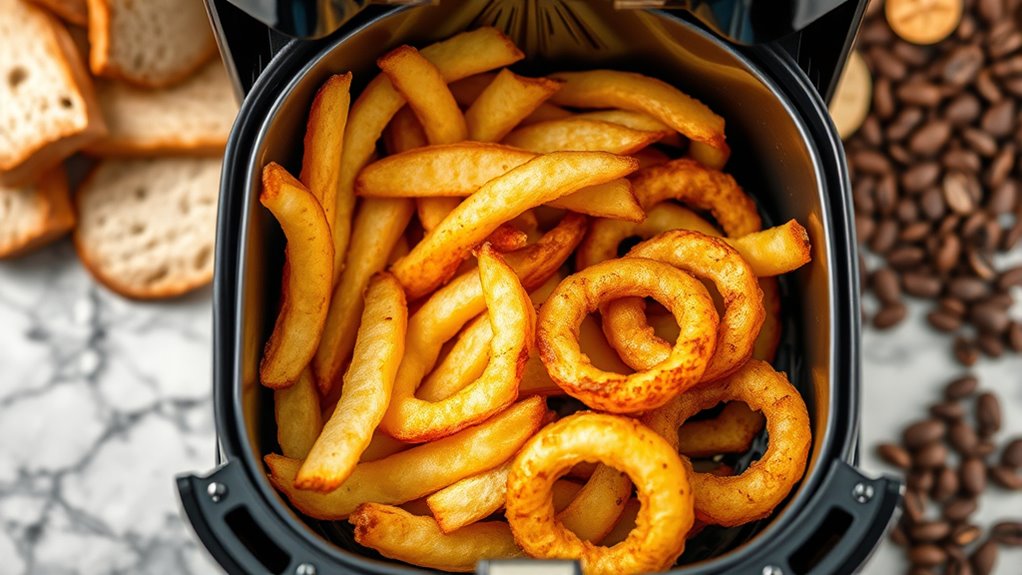
Potatoes, especially when turned into fries or chips, are highly prone to forming acrylamide during air frying at high temperatures. Baked goods and bread with lots of carbs can also develop this compound if overcooked or browned too much. Even roasted coffee beans can contain increased acrylamide levels when processed at high heat in an air fryer. Managing cooking temperatures carefully is essential to minimize acrylamide formation and ensure food safety. Additionally, selecting natural materials and avoiding overly processed foods can further reduce acrylamide intake.
Potatoes and Chips
Potato products like fries and chips are especially prone to forming acrylamide when cooked at high temperatures in air fryers. To reduce acrylamide levels, you should consider soaking potatoes in water for at least 15 minutes before air frying. This simple step helps with acrylamide reduction by leaching out some of the precursors that form during high-temperature cooking. Keep in mind that cooking methods matter: frying or baking at temperatures above 120°C (248°F) increases the risk. To maintain a crispy texture while minimizing acrylamide, opt for lower temperatures and shorter cooking times. Overcooking potatoes to a dark or burnt color also boosts acrylamide formation. Additionally, choosing appliances with filtering technologies can help improve overall air quality while cooking. Using proper temperature control can further reduce the formation of harmful compounds during cooking. Maintaining consistent aura health and monitoring cooking conditions can contribute to safer food preparation. For even better safety, selecting healthy cooking techniques can help you enjoy your favorite snacks with less health risk. By adjusting your approach, you can enjoy delicious, crispy chips with less health risk.
Baked Goods and Bread
When you bake bread, cookies, or crackers in an air fryer, high temperatures can cause the Maillard reaction to produce acrylamide, especially if the baked goods become overly browned or burnt. To minimize acrylamide formation, consider:
- Using lower air fryer temperatures
- Shortening cooking times
- Avoiding excessive browning or burning
- Choosing lighter-colored baked goods
- Monitoring browning levels carefully
The Maillard reaction responsible for browning in baked goods tends to increase acrylamide levels at temperatures above 120°C (248°F). While baked bread and cookies are delicious, overdoing it can heighten acrylamide risks. By adjusting cooking times and temperatures, you can enjoy tasty baked goods without compromising your health. Additionally, understanding personality traits can help you better manage your cooking habits and preferences, leading to safer and more enjoyable baking experiences. Being aware of potential health risks associated with high-temperature cooking can further guide you in making safer choices. Incorporating proper cooking techniques can also significantly reduce acrylamide formation during baking. Moreover, paying attention to food composition can influence acrylamide levels, as carbohydrate and amino acid content play a role in its formation.
Roasted Coffee Beans
Roasting coffee beans in an air fryer offers a quick and convenient way to develop your preferred flavor, but it also influences acrylamide levels. During high-temperature cooking, acrylamide naturally forms in roasted coffee beans, especially at temperatures above 120°C (248°F). The level of acrylamide depends on roasting time and temperature—lighter roasts tend to have higher acrylamide than darker ones. Using an air fryer for roasting can increase acrylamide if beans are exposed to very high heat or extended roasting times. To improve food safety, you should carefully control the roasting temperature and duration in your air fryer to reduce acrylamide formation. Proper roasting methods help balance flavor development with minimizing potential health risks. Additionally, understanding the best free keto diet app can support your health goals as you make dietary choices related to roasted foods.
Practical Tips to Minimize Acrylamide When Using Your Air Fryer
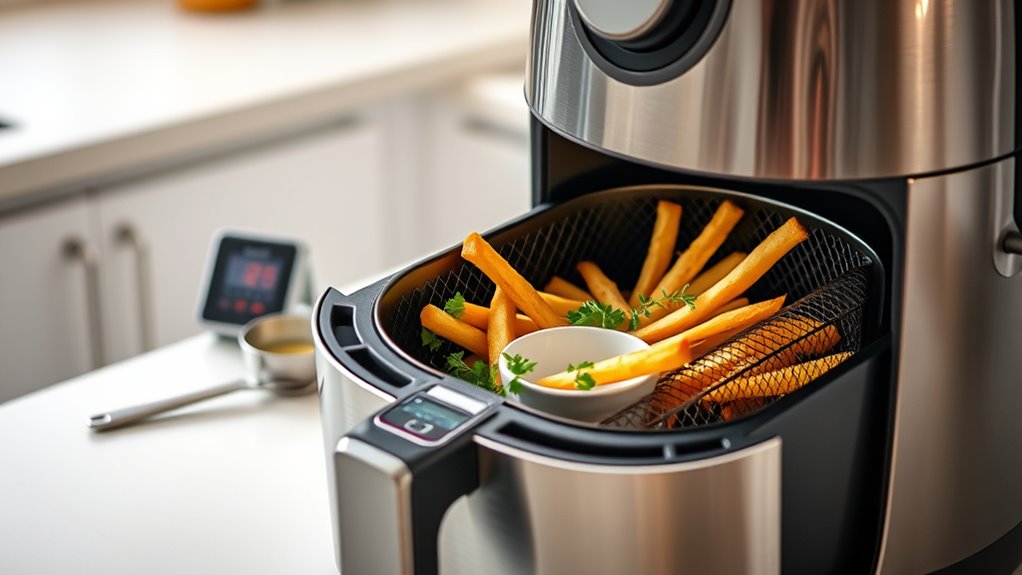
To reduce acrylamide when using your air fryer, start by soaking and pre-cutting vegetables to wash away surface sugars. Adjust your cooking temperature and time to avoid over-browning or burning, which increases acrylamide formation. Staying attentive to these steps helps you enjoy healthier, safer fried foods. Using HEPA filtration in your kitchen can help remove airborne particles generated during cooking, further improving air quality. Additionally, proper air circulation can help disperse pollutants and maintain a cleaner environment. Incorporating proper kitchen ventilation techniques can further reduce indoor pollutants related to cooking. Ensuring that you select organic produce when possible can also contribute to healthier cooking practices by reducing exposure to pesticides. Employing protective styling techniques such as crochet styles for locs can also minimize the need for frequent heat styling, reducing the risk of additional chemical exposure.
Soak and Pre-Cut Vegetables
Did you know that soaking vegetables like potatoes and sweet potatoes before air frying can markedly cut down on acrylamide formation? Soaking helps wash away surface sugars and reduces browning, key factors in acrylamide reduction. When preparing, cut vegetables into uniform pieces to ensure even air fryer cooking, which minimizes overcooking and uneven browning. After soaking, thoroughly dry the pre-cut vegetables to control moisture content, leading to better crispness and browning control. This simple step not only prevents overcooking but also helps keep acrylamide levels low. Incorporating proper preparation techniques can significantly enhance the safety and healthfulness of your air fryer meals while maintaining delicious, crispy results. Additionally, choosing appropriate cooking temperatures and times can further reduce harmful compound formation. Monitoring cooking times and temperatures closely is essential for optimal safety and taste.
Adjust Cooking Temperatures
Adjusting your air fryer’s temperature is key to reducing acrylamide formation. Using a lower air fryer temperature, around 350°F (175°C), helps limit the risk of acrylamide developing during cooking. Higher cooking temps above 400°F (200°C) accelerate acrylamide formation and increase browning, which can compromise food safety. To minimize this, choose the minimum effective temperature that still achieves your desired crispiness, and focus on shorter cooking times. Regularly monitor and adjust your air fryer settings based on the food type and size to prevent overcooking. Proper temperature adjustment not only reduces acrylamide levels but also ensures safer, evenly cooked food. Controlling cooking temperatures is a practical step towards healthier air frying. Additionally, considering expert reviews on optimal cooking practices can help you achieve better results while minimizing health risks. Being mindful of food moisture content can also influence acrylamide formation, as drier foods tend to produce more acrylamide when cooked at high temperatures.
Avoid Overcooking and Burning
Overcooking and burning foods in your air fryer considerably increase acrylamide levels, so paying attention to browning is essential. When food turns dark brown or burnt, it signals higher acrylamide formation, which affects food safety. To prevent this, aim for a golden hue by adjusting cooking temperature and time. Use a food thermometer to keep internal temperatures below 120°C (248°F), minimizing acrylamide development. Regularly shake or flip your food to promote even browning and avoid hotspots that cause burning. Remove items promptly once they reach the ideal color to prevent overcooking.
- Set shorter cooking times and lower temperatures
- Monitor internal food temperature carefully
- Keep an eye on browning to prevent burning
- Shake or flip food for even browning
- Remove foods at a light golden hue
The Role of Cooking Time and Temperature in Acrylamide Levels
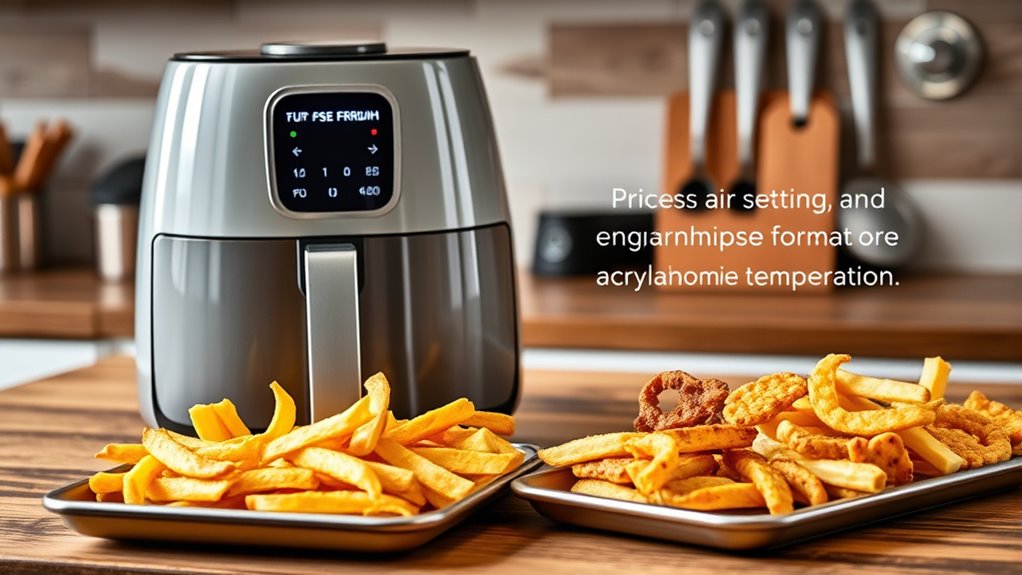
Cooking time and temperature play crucial roles in determining acrylamide levels in foods, especially when it comes to starchy items like potatoes. During air frying, higher cooking temperatures accelerate acrylamide formation, increasing health risks. To improve food safety, it’s important to balance cooking temperature and time; cooking at lower temperatures or for shorter durations can help reduce acrylamide without sacrificing crispy textures. High-temperature cooking methods, like frying or baking above 120°C, tend to produce more acrylamide, but adjusting these factors can make a difference. Shortening cooking time at elevated temperatures also minimizes chemical risks while still delivering delicious, crispy foods. By monitoring and controlling these variables, you can enjoy healthier, safer air-fried dishes with less acrylamide formation.
How Food Storage and Preparation Affect Chemical Risks
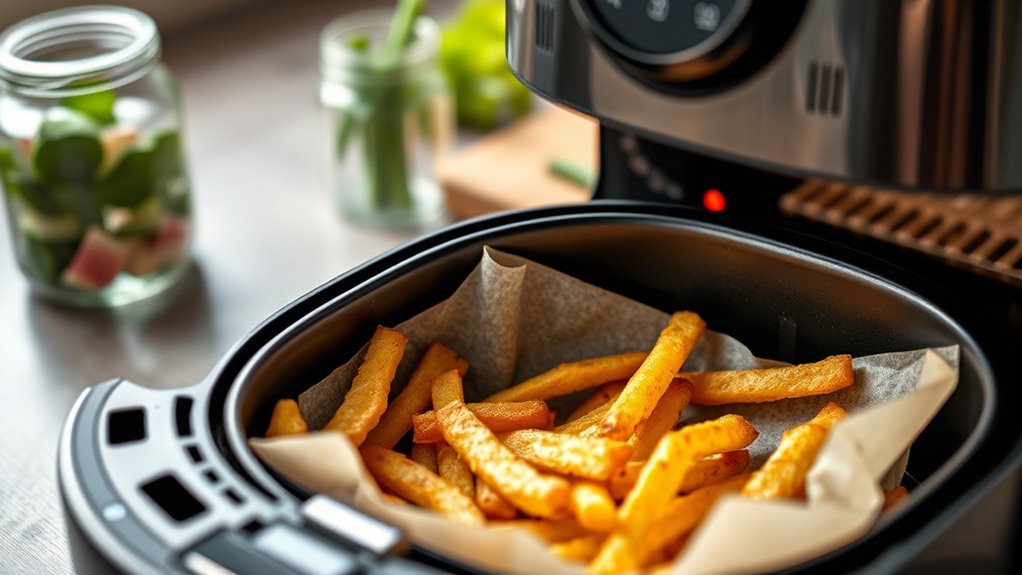
Proper food storage and preparation are essential steps in reducing chemical risks like acrylamide formation during air frying. How you store and prepare foods, especially starchy foods like potatoes, impacts acrylamide levels.
- Store root vegetables in cool, dark places to lower sugar content and reduce acrylamide formation.
- Soak potatoes in water for at least 15 minutes to wash away surface sugars and amino acids that promote chemical risks.
- Avoid overcooking or burning foods during air frying to prevent excessive browning linked to higher acrylamide levels.
- Use acidic ingredients like citric acid or salt during preparation to inhibit the Maillard reaction.
- Store potatoes at room temperature instead of in the fridge to prevent sugar conversion that increases chemical risks during cooking.
Comparing Acrylamide Levels in Air-Fried and Deep-Fried Foods

When comparing acrylamide levels in air-fried and deep-fried foods, it’s clear that air frying generally produces substantially less of this chemical. This is due to the lower cooking temperatures and shorter times used in air fryers, which reduce the Maillard reaction responsible for acrylamide formation. Studies show that while deep frying can generate acrylamide levels exceeding 1000 micrograms per kilogram in starchy foods like potatoes, air frying often results in levels below 200 micrograms. Less oil absorption and moderate browning in air frying contribute to improved food safety and health outcomes. By choosing an air fryer over deep frying, you minimize acrylamide exposure, making your cooking methods safer while still enjoying crispy, browned foods.
Additional Strategies for Healthier, Safer Air Fryer Cooking

To make your air frying healthier and safer, try soaking starchy vegetables like potatoes in water for at least 15 minutes before cooking. This simple step helps reduce acrylamide formation by washing away surface sugars that contribute to it. Additionally, aim for golden-brown rather than dark or burnt food, as excessive browning indicates higher acrylamide levels. Lowering the temperature and shortening cooking time can also considerably reduce acrylamide without sacrificing crispiness. Incorporate natural acids like lemon juice or vinegar during food preparation to inhibit acrylamide formation. Proper storage of root vegetables in cool, dark places reduces sugar buildup, further lowering risks.
- Use lower temperatures and shorter cooking times
- Avoid over-browning foods during air fryer cooking
- Incorporate natural acids in food preparation
- Store vegetables properly to minimize sugar accumulation
- Focus on healthy air frying techniques for food safety
Staying Informed: Emerging Research and Recommendations
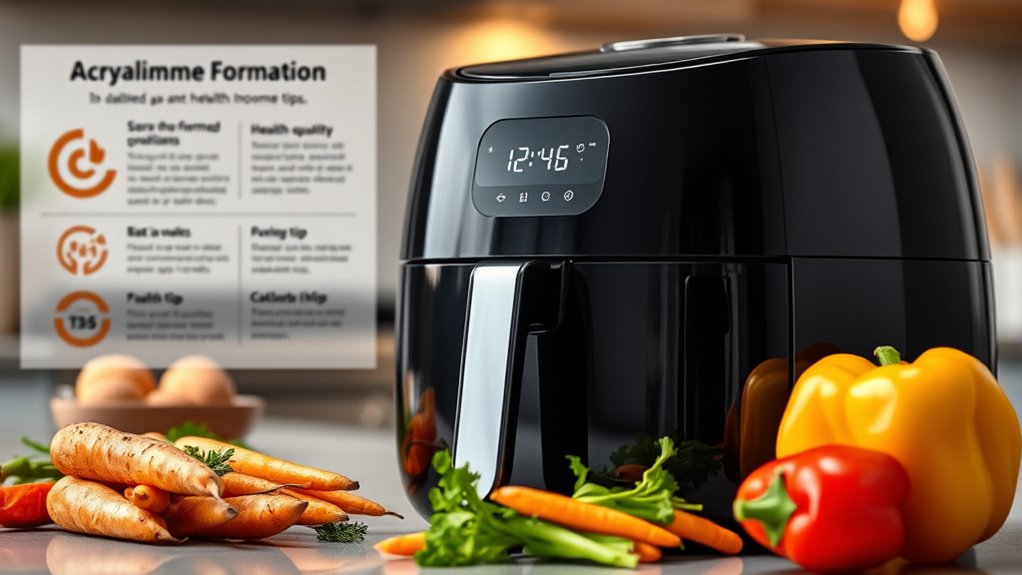
Staying informed about emerging research and recommendations is essential for optimizing your air frying practices and minimizing health risks. Recent research studies show that air frying can reduce acrylamide formation by approximately 75-90% compared to traditional deep frying. Monitoring cooking temperatures and times is critical to achieve acrylamide reduction and ensure food safety. Health guidelines are evolving as new data emerges, emphasizing the importance of adjusting high-temperature cooking methods to lower harmful compound formation. Incorporating pre-treatment methods, like soaking or using natural acids, can further decrease acrylamide levels in carbohydrate-rich foods. Staying updated on these developments allows you to adopt best practices for safer air frying, aligning with ongoing research and regulatory recommendations for healthier, more informed food preparation.
Frequently Asked Questions
Do All Air Fryers Expose You to Acrylamide?
Not all air fryers expose you to acrylamide equally. You need to pay attention to cooking temperature, time, and food type, as these factors influence acrylamide levels. Using lower temperatures and shorter cooking times helps reduce your exposure. High-quality models with precise controls prevent overcooking or burning, further lowering risk. Always follow recommended guidelines and avoid overly dark or burnt foods to minimize acrylamide formation in your air fryer.
How to Reduce Acrylamide in an Air Fryer?
To reduce acrylamide in your air fryer, start by soaking starchy foods like potatoes in water for at least 15 minutes before cooking. Keep the food’s color golden-yellow instead of dark brown, and lower the temperature and cooking time. Adding ingredients like citric acid or sodium chloride can help, and storing root vegetables in cool, dark places reduces sugar content. These steps help minimize acrylamide formation during air frying.
How Worried Should I Be About Acrylamide?
You shouldn’t be overly worried about acrylamide when using your air fryer. While it does form during high-temperature cooking, air frying produces considerably lower levels compared to deep frying. By following proper techniques—like avoiding over-browning and soaking potatoes—you can further reduce exposure. Overall, using your air fryer with mindful practices poses minimal health risks, making it a safer option for preparing crispy foods without notable concerns about acrylamide.
What Is Unhealthy About an Air Fryer?
You might wonder what’s unhealthy about an air fryer. While it cooks food with less oil, it can still produce harmful compounds like acrylamide, especially if you overcook or burn starchy foods at high temperatures. Using excessive heat or prolonged cooking increases chemical formation. Although healthier than deep frying, if you don’t monitor your cooking, you risk consuming these potentially carcinogenic substances, making it less safe.
Conclusion
By understanding how acrylamide forms and taking simple precautions, you can enjoy your air fryer without undue concern. Stick to recommended temperatures, avoid overcooking, and choose your foods wisely—think of it as wielding a modern alchemist’s tool with prudence. Staying informed about new research and best practices guarantees your culinary adventures remain both delicious and safe. After all, in this age of innovation, wisdom is your greatest ally—much like the sages of old guiding the way.
